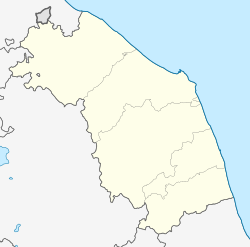Domus del Mito
The Domus del Mito excavated beginning in 2003 was a large noble house (domus) built towards the end of the 1st century AD. The Domus is one of the most important archaeological discoveries of the last 50 years. [3]
It has an area of approximately 1,000 m2 (11,000 sq ft) and 27 rooms. [4] It was embellished with a rich complex of monochrome and polychrome figurative mosaics of excellent quality and mostly splendidly preserved. They exhibit various subjects with many figures, mostly linked to classical mythology, which have given it the name "Domus del Mito" (house of myths). The mosaics indicate the inclusion of the city in the circuit of specialised mosaic workers, and of cultured and refined owners. Among the themes depicted are particularly: Neptune and Amphitrite on the triumphal chariot pulled by sea horses followed by Dionysus, god of wine and then arriving at the petrifying face of Medusa. Another spectacular room is the triclinium in which a hunting and fishing scene are depicted surrounded by a festive repertoire of black and white geometric motifs. [5]
Description
The Domus is located in the "Campo della Pieve". The Roman street was to the West of the house along a N/S axis and the entrance (vestibulum) was in room 6 with the Triumph of Neptune mosaic. From there the visitor would pass over a sandstone threshold and along a corridor with a mosaic floor depicting four two-tone geometric squares except for a pink floral element (room 20). This leads to the atrium-peristyle and to rooms 19 and 16, probably the tablinum next to which was a bedroom (cubiculum) in which is a geometric mosaic whose design is off-centre and depicting the face of Bacchus. [6]
From the corridor of the atrium, with a geometric mosaic with hexagons alternating with rhombuses, the dining room (triclinium) was reached from two other rooms, arranged symmetrically to the north and south, also used during banquets or meetings. In the triclinium is a hunting scene with fishing scene in the centre surrounded by many zoomorphic and mythological figures and a festive repertoire of black and white geometric motifs.
In the adjacent room to the south is a mosaic with the face of Medusa inside a hexagon while in the north room a mosaic in the form of a carpet to the west of which is a rectangle with pairs of animals. Rooms 23 and 24 are baths and a changing room area and perhaps room 21 (monochrome geometric mosaic) was used for the relaxation of guests. The rooms without flooring along the southern side are for domestic activities and in which loom weights and needles were recovered. Room 7 in the N/W corner along the road seems to have been used as a kitchen and subsequently for artisanal production of ceramics.











